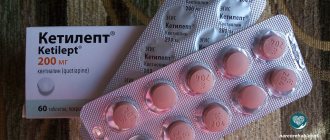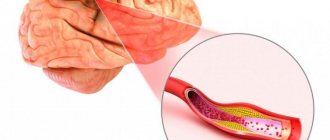Tranquilizers are a group of psychotropic drugs with an anti-anxiety effect, relieving anxiety and internal tension, anxiety, tremors and muscle tension of neurotic origin, and a feeling of fear. Some drugs in this group, in addition to their normalizing psycho-emotional state and nighttime sleep effect, can have a tonic effect.
Among tranquilizers (from the Latin tranquillo - to calm down) there are typical and atypical ones, which do not have pronounced non-core effects and do not cause dependence when taken for a long time. Based on their chemical structure, anxiolytics are divided into benzodiazepine derivatives (chlordiazepoxide, diazepam, phenazepam, oxazepam, medazepam, midazolam) and drugs of other chemical groups (meprotane, benactizine, phenibut, mebicar, benzoclidine).
The pharmacodynamic activity of all anxiolytics comes down to five main components: sedative, anti-anxiety, hypnotic, relaxant and anticonvulsant. Each specific drug has its own degree of severity of a particular therapeutic effect, which determines its clinical use (for example, in psychiatry, neurology, cardiology, gastroenterology, otolaryngology, anesthesiology).
Anxiolytics are prescribed to relieve states of agitation (1) and asthenia (2) accompanying various mental disorders:
- anxiety, panic, fear, irritability, dysphoria, problems with going to bed, decreased sleep duration, autonomic lability, autonomic crises;
- asthenia, chronic fatigue, hypochondria, problems with attention and remembering information, decreased intellectual activity, weakness, fatigue, lethargy, apathy, irritability, lack of vigor after sleep.
As a rule, the above conditions occur against the background of the following mental disorders:
- neuroses and neurosis-like conditions (F40–F48);
- behavioral disorders in children and adolescents (F91);
- personality disorders (F60–F69);
- fears and phobias (F40);
- insomnia (F51);
- panic attacks (F41);
- generalized anxiety disorder (F41.1);
- mixed anxiety and depressive disorder (F41.2);
- schizotypal disorder (F21);
- acute psychoses (F23, tranquilizers are prescribed as part of complex therapy);
- anorexia (F50.0–F50.1 and bulimia (F50.2);
- psychosomatic diseases (F04–07; F44.4–F44.7; F45; F50–F53).
In the practice of a neurologist, tranquilizers can be prescribed, for example, when states of agitation and asthenia occur due to traumatic brain injuries, strokes accompanied by increased muscle tone, epilepsy, and spinal osteochondrosis. Other somatic doctors prescribe anxiolytics for the treatment of functional disorders in the gastrointestinal tract (gastroenterologist), cardiovascular system (cardiologist), urinary system (gynecologist, urologist), withdrawal states and consequences of organic damage to the central nervous system (narcologist, toxicologist).
Mechanism of action of tranquilizers
The therapeutic mechanism of action of tranquilizers is the ability to influence the interneuronal transmission of nerve impulses in the diencephalon (intermediate) and spinal cord, reduce the activity of subcortical areas of the brain, reduce the level of dopamine and norepinephrine, as well as processes in the GABA systems of the brain, and block cholinergic receptors.
A feature of the therapeutic effect of tranquilizers is a calming effect on the central nervous system, excluding a pronounced antipsychotic effect. Therefore, they are widely used for mild (reversible) disorders of the central nervous system as an alternative to antipsychotic drugs.
The mechanism of action of tranquilizers depends on their chemical structure. Among anxiolytics, six classes of organic substances can be distinguished, represented by main chemical groups (according to the Anatomical Therapeutic Chemical Classification of Medicines, ATC):
- benzodiazepine derivatives;
- diphenylmethane derivatives;
- carbamates;
- dibenzo-bicyclo-octadiene derivatives;
- azaspirodecanedione derivatives;
- other anxiolytics.
The targets of anxiolytics are the following brain structures:
- limbic system of the hypothalamus;
- reticular formation of the brain stem,
- thalamic nuclei.
To date, the mechanism of action of tranquilizers of benzodiazepine derivatives has been well studied. Benzodiazepine receptors are involved in biochemical processes associated with GABAergic inhibition at all levels of the central nervous system. The versatile activity of tranquilizers is determined by their effect on various types of benzodiazepine receptors, thus allowing them to have anxiolytic, sedative, hypnotic, muscle relaxant and anticonvulsant effects.
Rice. 1. The mechanism of action of tranquilizers.
Anxiolytic (anti-anxiety) effect
The main task of tranquilizers is to provide an anxiolytic (anti-anxiety) effect: relieve anxiety, anxiety, fear (antiphobic effect), reduce emotional stress. In addition, anxiolytics help to cope with obsessive thoughts and hypochondria, irrational worries about one’s own health.
Tranquilizers are not antipsychotic drugs, so they do not relieve hallucinations, delusions, affective and productive disorders. Their therapeutic effect is aimed at other structures in the nervous system that are not responsible for the occurrence of such symptoms.
Sedative (calming) effect
Anxiolytics have a sedative (calming) effect, which is expressed in a decrease in hyperactivity, psychomotor excitability, speed of motor and mental reactions, and concentration. The sedative effect can be considered complementary to the anxiolytic.
Hypnotic effect
In case of sleep disorders (difficulties in falling asleep, in the presence of superficial sleep, sensitive to external stimuli, as well as short sleep, insufficient for restoration of strength), which, as a rule, arise against the background of mild and borderline mental disorders, tranquilizers help to cope with these conditions through a hypnotic (hypnotic) effect.
Muscle relaxant (relaxing) effect
In psychopathological conditions that cause tension in the skeletal muscles, muscle and motor excitation, the muscle relaxant (relaxing) effect of anxiolytics is useful. However, if the patient’s professional activity or lifestyle is associated with the need to maintain a rapid mental and physical reaction, strict selection of the drug in the correct dosage is necessary. Otherwise, a subjective feeling of lethargy and weakness may appear.
Anticonvulsant effect
The anticonvulsant effect of tranquilizers is usually used for conditions accompanied by epileptogenic activity. In particular, this effect finds therapeutic use in hysteroepilepsia (non-epileptic paroxysmal conditions), non-convulsive epilepsy, neuropsychogenic seizures (for example, breath holding, parasomnia, panic disorder, cardiogenic seizures, tension headaches).
Vegetative stabilizing effect
The therapeutic action profile of some tranquilizers includes a vegetative stabilizing effect - stabilizing the functional activity of the autonomic nervous system. When taking such drugs, autonomic manifestations of anxiety are stopped, for example: rapid heartbeat, high blood pressure, sweating, gastrointestinal disorders.
Rice. 2. The principle of prescribing tranquilizers.
Tranquilizers - what are they?
The word tranquilizer comes from the Latin word "tranquillo", which means "calm". Another name for tranquilizers is anxiolytics. This word is also Latin, and literally means “relieving anxiety.”
Sedatives have been known to medicine since ancient times. These were mainly natural preparations based on herbs. However, tranquilizers are now usually understood to mean a group of synthetic drugs that act on benzodiazepine and GABA receptors in the brain. Although there are anxiolytics with an atypical mechanism of action, which affects not benzodiazepine, but serotonin receptors (spirotomine), or tranquilizers with a central anticholinergic or antihistamine effect (hydroxyzine, amizil).
The main function of tranquilizers is to reduce the rate of spread of excitation in the central nervous system. This leads to a decrease in the severity of psychomotor reactions to most stimuli.
Tranquilizers are distinguished by their inhibitory effect on the limbic system of the brain - the hypothalamus, hippocampus, reticular formation, thalamic nuclei. Since the limbic system is responsible for various emotional reactions, its suppression leads to dulling of emotions. Under the influence of a tranquilizer, a person ceases to feel the negative emotions that oppress him - anger, rage, fear, anxiety, restlessness. At the same time, however, most positive emotions are suppressed or dulled.
In addition to anxiolytic (anti-anxiety) many tranquilizers have sedative, anticonvulsant, muscle relaxant and hypnotic effects. Tranquilizers easily penetrate the blood-brain barrier, bind to blood proteins, accumulate in adipose tissue, and are excreted through the kidneys and intestines. Contrary to popular belief, tranquilizers do not affect cognitive functions - memory, intelligence, or this effect is transient.
Many tranquilizers also have a good hypnotic effect. Under their influence, the quality of night sleep and the ratio of fast and slow sleep phases are normalized. In patients with epilepsy, tranquilizers reduce the activity of brain centers that cause seizures. Thanks to their muscle relaxant effect, tranquilizers suppress motor excitation and relieve excessive muscle tension. The anticonvulsant and muscle relaxant effects of tranquilizers are associated with inhibition of spinal reflexes and nerve impulses of spinal cells.
Anxiolytics have a positive effect on the autonomic nervous system, reducing the severity of somatic symptoms of anxiety and fear, such as:
- tachycardia,
- increased sweating,
- increase in blood glucose concentration,
- increased pressure,
- disorders of digestion and intestinal motility.
From a chemical point of view, most (but not all) tranquilizers belong to the benzodiazepine class. This class of drugs is so firmly established in medical use that it seems incredible that benzodiazepines have been used for only a little more than half a century. The first such drug was synthesized in 1959. However, there are anxiolytics that are not benzodiazepines, for example, hydroxyzine (diphenylamine derivative), meprobamate (carbamine ester), buspirone, mebicar, phenibut.
There are currently more than a dozen substances on the list of anxiolytics. As a rule, they are available in tablet form. However, there are also liquid dosage forms for parenteral administration.
For what pathologies are anxiolytics used:
- anxiety disorders,
- panic states,
- depression,
- neuroses,
- phobias,
- insomnia,
- convulsions,
- withdrawal syndrome,
- hyperexcitability,
- nervous tics and hyperkinesis,
- vegetative-vascular dystonia,
- epilepsy,
- premenstrual and menopausal disorders,
- post-traumatic stress disorder,
- increased muscle tone,
- skin itching due to allergic diseases.
Anxiolytics are often prescribed in combination with other drugs - nootropics, antidepressants, antipsychotics.
Often, drugs of this series are used for premedication in preparation for surgical operations, for sedation of seriously ill patients with stomach ulcers, coronary artery disease, hypertension, as part of the complex treatment of chronic alcoholism and drug addiction, and addiction to tobacco.
Compatibility of anxiolytics with other substances
Anxiolytics enhance the effect:
- sedatives,
- antidepressants,
- antihypertensive drugs,
- neuroleptics,
- sleeping pills,
- antiparkinsonian drugs,
- alcohol,
- analgesics and anesthetics,
- cardiac glycosides,
- muscle relaxants.
They are incompatible with hormonal contraceptives, indirect anticoagulants, some anticonvulsants, irreversible MAO inhibitors, and alcohol.
Side effects and contraindications of benzodiazepines
The disadvantage of benzodiazapine anxiolytics is their inherent side effects:
- lethargy,
- drowsiness,
- decreased psychomotor reactions,
- addiction,
- development of drug dependence with long-term use,
- decrease in blood pressure.
Also possible:
- coordination problems,
- decreased libido,
- urinary incontinence,
- dizziness,
- muscle weakness.
Most strong tranquilizers are contraindicated during pregnancy, breastfeeding and childhood.
Other contraindications for benzodiazepine drugs:
- breathing disorders,
- severe muscle weakness,
- chronic liver and kidney diseases,
- acute alcohol or drug poisoning.
Constant use of anxiolytics by people whose work requires increased attention (drivers, dispatchers, etc.) is not allowed. However, such patients can undergo a course of treatment with tranquilizers in a hospital setting.
Course of treatment with tranquilizers
Benzodiazepine medications are prescribed for a short period of time, no more than 2 weeks. If longer treatment is necessary, it is necessary to take a break from using the drugs for several days. In order to avoid withdrawal syndrome, when stopping taking the drug, its dose must be reduced gradually over several days. In some cases, treatment is also not started with the maximum dose, but is gradually increased. You should not take anxiolytics for longer than prescribed by your doctor.
Anxiolytic classes
Medicines of the anxiolytic class are usually divided into several categories depending on the effect of their effect. A strong anxiolytic effect is observed with diazepam, phenazepam, and alprazolam. Moderate – for clobazam, oxazepam, gidazepam.
Drugs such as estazolam, triazolam, nitrazepam have a stronger hypnotic effect than other anxiolytics.
Features of the action of some anxiolytics
| A drug | Effect | possible dosage of the drug, mg |
| Nitrazepam | drug with enhanced hypnotic effect | 5-15 |
| Clonazepam | a drug with a predominantly anticonvulsant effect | 0,5-2 |
| Clobazam | the drug has a more pronounced anticonvulsant effect | 20-60 |
| Triazolam | a drug with a strong hypnotic effect | 0,125-0,5 |
| Chlordiazepoxide | the drug has a more pronounced sedative effect | 15-150 |
| Phenazepam | the most powerful sedative effect compared to other drugs | 0,5-2,5 |
| Diazepam | with a small dose the drug has an activating effect, with a large dose it has a sedative effect | 5-60 |
| Mezapam | the drug has a slight activating effect | 10 |
Difference between anxiolytics and antidepressants and antipsychotics
Groups of drugs such as antidepressants and antipsychotics should not be confused with tranquilizers. The former do not have a sedative effect, since they do not affect the limbic system. Instead, they increase serotonin levels in the central nervous system. Thanks to this, the patient gets rid of depression caused by a lack of this neurotransmitter.
The effect of antidepressants is stimulating rather than inhibitory. Antidepressants improve a person's mood by enhancing positive emotions and suppressing negative ones.
As for antipsychotics, these drugs are effective for psychoses and related conditions - delusions, hallucinations, etc.
Side effects of tranquilizers
Tranquilizers confidently entered minor and borderline psychiatry in the second half of the 20th century as first-choice drugs, displacing antipsychotics and antidepressants, due to the lack of pronounced side effects and good tolerability. The search for new drugs in this group has been going on since 1959, after the first tranquilizer, chlordiazepoxide (Elenium), proved itself to be the best in clinical practice. It is worth noting that today there are more than 50 types of benzodiazepine tranquilizers alone, which have an improved action profile and tolerability.
Abuse and non-medical use
The main side effects of tranquilizers that occur due to abuse or non-medical use of drugs in this group include:
- hypersedation - drowsiness, decreased concentration, memory problems;
- hypermyorelaxation - lethargy, muscle weakness;
- behavioral toxicity - impairment of cognitive functions and psychomotor skills;
- paradoxical reactions - agitation, aggressiveness, sleep disturbances;
- Dependence - mental and physical dependence with manifestations of neurotic anxiety.
Drug intoxication
The effects of abuse and non-medical use of tranquilizers are somewhat similar to barbiturate addiction. The consequences of intoxication depend on the drug taken, however, the severity of the side effects of tranquilizers is small and does not reach serious intellectual, mental and affective disorders. Such drug intoxication can be expressed in a variety of conditions:
- analogue of alcohol intoxication;
- severe lethargy;
- decreased reaction speed;
- drowsiness;
- excessive muscle relaxation;
- increased physical activity;
- euphoria.
The side effects of tranquilizers when used over a long distance are reflected in the appearance and behavior of a person, obvious to others. In such a person, coordination of movements is impaired, the gait becomes sluggish and staggering; speech is unintelligible and confused, but animated; the condition of the skin worsens - it becomes pale; pupils are dilated and react sluggishly to light; the oral cavity is dry, the tongue is covered with a white coating.
Non-medical use of tranquilizers leads to addiction. It is expressed in a change in the nature of intoxication, increasing the dosage of the drug taken in order to achieve the same effect (euphoria). However, euphoria and disinhibition are replaced by irritability and aggression. Ultimately, acute intoxication with tranquilizers leads to the development of a psychotic state - hallucinations, disorders of consciousness, psychomotor agitation. An overdose can lead to coma.
From the somatoneurological side, side effects of tranquilizers can be expressed by the following conditions:
- photophobia;
- hyperhidrosis;
- tachycardia (pulse rate reaches 100 beats per minute);
- hypotension;
- hyperthermia;
- dizziness;
- nausea, vomiting;
- blurred vision;
- tinnitus;
- headaches;
- tactile hypersensitivity;
- olfactory hypersensitivity;
- attacks of fever and chills;
- convulsive seizures.
Treatment for tranquilizer dependence includes drug withdrawal and psychosocial rehabilitation. As a rule, abrupt cessation of taking tranquilizers can cause withdrawal symptoms, accompanied by epileptic seizures, therefore, during treatment, it is necessary to replace it with another (weak) tranquilizer in order to gradually reduce the dosage.
Psychopathology associated with long-term non-medical use of tranquilizers varies from mild anxiety-phobic states to a state of depersonalization-derealization. In addition, in the process of addiction treatment there is a high likelihood of increased low mood, hypochondriacal conditions, lack of initiative and sleep disturbances, which can lead to depression. Having an impact on the quality of life in general, such a person necessarily needs long-term work with a psychotherapist, including in the area of resocialization.
Top 10 drugs from the pharmacy
Tranquilizers can be divided into those that require a doctor's prescription and those that can be purchased freely. The 1st (in accordance with the Rules adopted in 2021) include drugs containing narcotic and psychotropic substances, the consumption of which (due to their danger to humans and a large number of contraindications) is controlled at the state level.
There are no such ingredients in commercially available drugs. Most often, these are “night” tranquilizers of the new generation, which are considered relatively harmless and do not cause physical, psychological and emotional dependence.
Afobazole
Non-prescription tranquilizers presented by Afobazol are considered one of the best representatives of the category of new generation drugs. The active ingredient is afobazole (morpholinoethylthioethoxybenzimidazole dihydrochloride).
In addition to it, the composition contains auxiliary substances:
- starch;
- cellulose;
- lactose.
Afobazole:
- has an anti-anxiety and stimulating effect;
- eliminates feelings of panic and anxiety;
- fights irritability, tearfulness, and sleep disorders.
The drug does not:
- has a relaxing and sedative effect;
- causes addiction and dependence;
- affects the ability to concentrate and memory.
Afobazole is indicated for use by adult patients with:
- anxiety and neurasthenia;
- somatic, dermatological and oncological diseases;
- sleep disturbances due to obsessive thoughts, anxiety;
- premenstrual syndrome;
- hangover and smoking cessation syndrome.
Contraindications include:
- pregnancy;
- feeding period;
- children's age (up to 18 years);
- sensitivity to the components of the drug.
In case of an overdose, drowsiness may develop, and side effects include allergies and headaches. These symptoms disappear on their own when the drug is discontinued and no treatment is required.
The product is available in the form of tablets of 10 mg (pack of 60 pieces). The tablets are taken three times a day after meals and washed down with a small amount of liquid. The recommended dose is 1 tablet, the duration of treatment is from 2 to 4 weeks. On the recommendation of a doctor, it is allowed to increase the daily dose to 6 tablets and the course duration to 3 months.
The price of one package is 438 rubles.
Benactizine (Amizil)
A drug based on benactizine, a substance that has a sedative effect on the central nervous system. In addition to it, the tablets contain N-holibitors, which provide a slight relaxing effect and reduce muscle tone.
Benactizine:
- used in the treatment of nervous disorders accompanied by stress, a feeling of constant anxiety, depression;
- has an antihistamine effect;
- capable of suppressing the cough reflex.
The drug is prescribed for:
- emotional disorders;
- peptic ulcers, irritable bowel syndrome, cholecystitis;
- dermatitis (to relieve itching);
- if necessary, cough relief;
- for cramps and spasms.
- when preparing patients for surgery
Contraindications include:
- eye diseases (glaucoma);
- prostate adenoma;
- period of pregnancy and breastfeeding.
The drug should be used with caution in the elderly and children (there are no data on the effect of Benactizine on children). In addition, the drug is not recommended for those whose occupation requires maximum concentration.
Undesirable effects from taking the drug include:
- cardiopalmus;
- difficulty urinating;
- dizziness;
- dilated pupils;
- feeling of dry mouth;
- constipation;
- nausea.
In case of overdose, patients experience a state of agitation, convulsions, and sometimes hallucinations. Undesirable symptoms disappear after treatment with gastric lavage, taking absorbents and medications that neutralize the effect of Benactizine.
The drug can be available in tablets (1-2 mg) or powder. The recommended dose is 1-2 tablets, the number of doses is 3-4 times a day. As directed by the doctor, the daily dose can be increased to 10 or 12 mg.
Buspirone (Spitomin)
Buspirone is used for neuroses of various origins, nervous disorders accompanied by increased anxiety, irritability, and excessive reaction to external stimuli. The active substance of the drug is buspirone hydrochloride.
It also contains the following auxiliary ingredients:
- lactose;
- starch;
- MK-cellulose.
Buspirone has tranquilizer and antidepressant properties, does not have an anticonvulsant or relaxing effect, and is not addictive. After stopping the drug, there are no cases of “withdrawal syndrome” observed.
The therapeutic effect of taking Buspirone appears after 1-2 weeks of taking the drug, reaching a maximum in the 4th week of treatment. As a rule, the initial dose is 3 times a day before or after meals. A single dose is 5 mg. Next, every 2-3 days the daily intake is gradually increased by 5 mg until it reaches the optimal value of 20-30 mg. The maximum possible dose is 45 mg.
Taking the drug is contraindicated if:
- glaucoma;
- liver and kidney diseases;
- myasthenia gravis (quick muscle fatigue);
- epilepsy;
- allergies to the components of the product.
It should not be used in patients under the age of 18, as well as during pregnancy and lactation.
Possible side effects include:
- feeling of dry mouth;
- headaches and dizziness;
- tachycardia;
- nausea.
In case of overdose it is possible:
- drowsiness;
- disorders of the gastrointestinal tract;
- constriction of the pupils (miosis).
The drug is available in the form of powder or tablets (100 tablets per package). Price – about 950 rubles.
Mexidol
The active substance of the drug is ethylmethylhydroxypyridine succinate, a membrane protector that protects nerve cells from damage.
By improving blood circulation, Mexidol promotes:
- normalization of brain function;
- improving memory;
- increasing the body's resistance to stress and to other factors that negatively affect the functioning of the central nervous system.
The drug is indicated for:
- cerebral circulatory disorders leading to memory impairment and headaches;
- mild traumatic brain injury;
- dystrophic changes in brain tissue (encephalopathy);
- various autonomic disorders;
- weakening of memory and decreased performance;
- neuroses;
- relief of hangover syndrome.
Mexidol is successfully used to neutralize the effects of stress on the body and as a prophylactic agent, preventing the possible negative consequences of high emotional and psychological stress.
A drug:
- contraindicated in case of allergy to its components, acute renal and liver failure;
- not recommended during pregnancy and lactation, in childhood;
- taken with caution by people whose activities involve potential danger to others and require concentration.
Adverse reactions may include disturbances in the gastrointestinal tract, manifested as nausea and a feeling of dry mouth; in case of an overdose, drowsiness develops. The drug can be produced in the form of a 5% solution for injection and tablets of 30 or 50 pieces per package. Each tablet contains 125 mg of active ingredient.
Price:
- packing of tablets for 50 pcs. – 457 rub.;
- packing of tablets for 30 pcs. – 267 rub.;
- packs of ampoules of 2 ml (10 pcs.) – 467 rubles;
- packs of ampoules of 5 ml (5 pcs.) – 478 rub.
Depending on the characteristics of the disease and the doctor’s recommendations, Mexidol is taken 1-2 tablets three times a day, the course of treatment is from 2 to 6 weeks. The maximum daily dose is 6 tablets. If a repeated course of treatment is necessary, it is advisable to carry it out in the autumn or spring.
Phenibut
The drug has the following effects:
- nootropic: improves memory, increases performance, activates the activity of brain cells;
- anti-anxiety: eliminates nervousness, irritability, normalizes sleep.
Phenibut will alleviate the patient’s condition with:
- neuroses;
- chronic fatigue (asthenia);
- insomnia.
As a remedy that eliminates symptoms and accelerates recovery, it is used in the treatment of stuttering, alcohol and drug addiction.
With abrupt withdrawal, a “withdrawal syndrome” may develop; in addition, the drug can cause various undesirable reactions from the gastrointestinal tract.
Phenibut is available in packages containing from 10 to 50 tablets, each of which contains 0.250 g of the active substance (finylbutylic acid hydrochloride).
Average price per pack of 20 pcs. – 124 rub.
Alprazolam
Over-the-counter tranquilizers that are benzodiadesine derivatives are available over the counter in the form of the drug Alprazomlam. The drug has a complex effect on the central nervous system, being both a sedative and an anticonvulsant.
It has a muscle relaxant and hypnotic effect, which is achieved by partially blocking the activity of brain stem cells.
Applicable for:
- emotional stress;
- constant anxiety, feelings of fear and causeless worry;
- difficulty falling asleep, frequent awakenings at night, insufficient sleep duration;
- loss of appetite associated with a persistent deterioration in mood.
Alprazolam is contraindicated in:
- glaucoma;
- alcoholic coma;
- overdose and poisoning with other psychotropic drugs;
- diseases of the respiratory tract associated with manifestations of respiratory failure.
This medicine should not be used:
- during pregnancy;
- during lactation;
- patients under 18 years of age
Like all benzodiadesine-based drugs, Alprazolam is addictive when taken over a long period of time and, if the drug is abruptly discontinued, a “withdrawal syndrome” occurs.
Also among the negative effects:
- drowsiness, fatigue, decreased attention, sometimes disorders of the vestibular system;
- negative reaction of the gastrointestinal tract, manifested by heartburn, drooling, dry mouth, nausea, constipation or diarrhea;
- reaction of the urinary system: urinary incontinence or retention, kidney problems.
The drug is available in the form of tablets of 0.25 mg, each package contains 50 pieces, the price of the package is 930 rubles.
Alprazolam is taken 2-3 times a day before or after meals. The initial dose is 1-2 tablets. Afterwards, the dose is gradually increased by taking 1 more tablet, first in the evening, then in the evening and morning. The course of treatment is from 3-5 days to 3-4 months. It is recommended to reduce the dose gradually.
Grandaxin (Tofisopam)
The active ingredient of the drug, which belongs to the “daytime” tranquilizers, is tofisopam (a group of benzodiazepines). Grandaxin is a mild psychostimulant that does not have a muscle relaxant effect and does not lead to a decrease in reaction speed and drowsiness. Not addictive.
Accepted for the following conditions:
- reactive depression associated with the impact of negative factors on a person’s emotional state;
- nervous disorders due to severe stress;
- menopausal syndrome and PMS;
- alcohol withdrawal (hangover);
- neurotic disorders: anxiety, irritability, tearfulness.
The drug is contraindicated:
- with deep depression;
- with pronounced overexcitation;
- in early pregnancy;
- during lactation;
- under the age of 18;
- with galactose intolerance and hypersensitivity to the substances included in the product.
The list of side effects:
- disturbances in the functioning of the central nervous system, manifested by migraines, insomnia, irritability;
- allergic reactions in the form of itching;
- respiratory depression.
For this reason, it should be taken with caution for various respiratory diseases. In case of overdose, drowsiness and difficulty breathing develop. Grandaxin is available in tablets, each of which contains 50 mg of tofisopam. There are 60 tablets in the package, the price is 681 rubles.
The dose depends on the severity of the patient's condition, usually adults are prescribed 1-2 tablets 1-3 times a day, but not more than 6 tablets per day. For elderly patients and people with kidney disease, the rate is halved.
Medazepam
A classic “daytime” tranquilizer based on benzodiazepine derivatives, which has a pronounced anti-anxiety and sedative effect. Sedative, hypnotic, anticonvulsant and relaxing effects are weak.
The drug is prescribed for:
- neuroses;
- psychopathy;
- increased nervousness, excitability;
- frequent and sudden changes in mood (emotional lability);
- obsessive fears, causeless anxiety, restlessness;
- sleep disorders associated with nervous excitement;
- persistent migraines.
It can also be used to eliminate excessive excitability in children (on the recommendation of a doctor) and in drug treatment practice - to combat the manifestations of uncomplicated withdrawal syndrome.
Contraindications include:
- allergic reaction to the components of the drug;
- glaucoma;
- tendency to stop breathing during sleep (night apnea);
- kidney and liver diseases (in the acute stage);
- circulatory problems.
Pregnant women can take the drug from the 2nd trimester (for medical reasons), school-age children (from 10 years old) Medazepam is prescribed only on the recommendation of a pediatrician. The effect of the drug on the body of a child in the first year of life is not fully understood, therefore it is recommended to exclude breastfeeding for the entire period of treatment.
Medazepam can cause a number of undesirable side reactions from the nervous system, heart, respiratory system and gastrointestinal tract.
Among them:
- drowsiness;
- fast fatiguability;
- hypotension, tachycardia;
- difficulty breathing;
- nausea, constipation/diarrhea.
There may also be problems with urination, allergic reactions, and with long-term use, addiction to the drug and a decrease in its effectiveness, development of emotional and physical dependence.
Medazepam is available in the form of granules for the preparation of a suspension (used in pediatric practice) and in the form of tablets (for adults). Each tablet contains 10 mg of active ingredient, there are 50 tablets in a package, the price is from 950 to 1055 rubles.
For adults, the drug is taken before meals, the initial single dose is 5 mg (½ tablet), the number of doses is 2-3 per day. The daily dose is gradually increased to 30 mg, sometimes, on the recommendation of a doctor, to 40 mg, which is the maximum dose when taken independently.
In hospital treatment conditions, the maximum possible dose is 60 mg. The duration of the course is 2 months; if it is necessary to take it again, a break of 3 weeks is required. Elderly patients are prescribed 1-2 tablets per day.
For children, the following daily dosages of Medazepam (in the form of a suspension) are indicated:
- up to 3 years – 2-3 mg;
- from 3 to 6 years – 3-6 mg;
- from 7 to 10 years – 6-24 mg;
- over 10 years – 20 mg.
Oxylidine
Over-the-counter tranquilizers based on benzodiline, for example, Oxilidine, have a pronounced sedative and hypotensive effect.
This remedy is used for:
- depressive states;
- psychopathological syndrome;
- nervous disorders manifested by increased excitability;
- sleep disorders (insomnia, frequent awakenings, nightmares);
- hypertension complicated by disorders of brain activity.
Contraindications include hypotension and kidney disease.
Possible side effects include:
- dry mouth;
- skin rashes (observed in case of hypersensitivity to the components of the drug);
- frequent urge to empty the bladder;
- feelings of mild intoxication.
Oxylidin is available in tablets of 20 and 50 mg (100 pieces per package) or ampoules containing 5 ml of 25 or 5% solution (10 pieces per package). When using tablets, a single dose of 20 mg is initially prescribed, the number of doses is 3-4 times a day. If necessary, the daily dose is gradually increased to 4-6 tablets (50 mg each). The maximum dose per day is 500 mg.
When administering the drug intramuscularly, use 1 ml of a 2% solution, then increase the dose to 2 ml of a 5% solution. Injections are performed twice a day.
Gidazepam
It belongs to the “daytime” tranquilizers of the benzodiazine series, has anti-anxiety, anticonvulsant and nootropic effects.
The drug is used for:
- migraines;
- increased irritability;
- sudden changes in mood;
- anxiety;
- weakening of memory;
- as a means to alleviate a person’s condition when quitting smoking and alcohol;
- as a sedative that does not cause drowsiness (if the dose is observed).
Gidazepam is contraindicated in:
- hypersensitivity to benzodiazipine derivatives;
- liver diseases;
- rapid muscle fatigue (myasthenia gravis);
- pregnancy and breastfeeding.
The drug should be taken with caution if you have glaucoma and other eye diseases, as well as people whose professional activities require extreme composure and speed of reaction.
In case of overdose, taking the drug can cause the opposite effect and cause:
- lethargy;
- drowsiness;
- weakening of attention;
- decreased performance.
With long-term use, addiction and development of drug dependence are possible.
Gidazepam is available in tablets of 20 mg (10 and 30 pieces per package), in tablets of 50 mg (10 pieces per package). The initial single dose is 20 mg, the number of doses is 3 times a day. If necessary, the single dose can be increased to 50 mg.
Buying a tranquilizer without a prescription is not difficult, but the fact of free sale does not make the drug absolutely safe. While it can easily relieve insomnia, anxiety, and nervousness, it can create other, more serious problems.
Article design: Vladimir the Great
List of tranquilizer drugs
In the international Anatomical Therapeutic Chemical Classification (ATC), adopted by the Ministry of Health of the Russian Federation in 2002, anxiolytics (N05B) are included in the subsection of the section Drugs for the treatment of diseases of the nervous system (N) - Psycholeptics (N05). This subsection includes six groups of tranquilizers:
- benzodiazepine derivatives (N05BA): Chlordiazepoxide, Medazepam, Oxazepam, Potassium clorazepate, Lorazepam, Adinazolam, Bromazepam, Clobazam, Ketazolam, Prazepam, Alprazolam, Galazepam, Pinazepam, Camazepam. Nordazepam, Fludiazepam, Ethyl loflazepate, Etizolam, Clotiazepam, Cloxazolam, Tofisopam, Lorazepam in combination with other drugs;
- diphenylmethane derivatives (N05BB): Hydroxyzine, Captodiam, Hydroxyzine in combination with other drugs;
- carbamates (N05BC): Meprobamate, Emilkamate, Mebutamate, Meprobamate in combination with other drugs;
- dibenzo-bicyclo-octadiene derivatives (N05BD): Benzoctamine;
- Azaspirodecanedione derivatives (N05BE): Buspirone;
- other anxiolytics (N05BX): Mefenoxalone, Gedocarnil, Etifoxine, Fabomotizol.
Below we present two lists of tranquilizers that can be prescribed for neuroses and neurosis-like mental disorders based on elements of the leading symptoms.
Rice. 1. Formula of the first tranquilizer.
Target - elements of agitation
Mild and borderline mental disorders may be accompanied by elements of agitation: anxiety, panic, fear, overvalued thoughts of fear, obsessive fears, irritability, dysphoria, difficulty going to bed, decreased sleep duration, vegetative lability, vegetative crises. Elements of agitation are the target of the following tranquilizers:
- Diazepam;
- Alprolasam;
- Phenazepam;
- Lorazepam;
- Clonazepam;
- Flurazepam;
- Medazepam;
- Oxazepam;
- Triazolam;
- Bratizolam;
- Tetrazepam;
- Clobazam;
- Gidazepam;
- Nitrazepam;
- Flunitrazepam.
Target - elements of asthenia
Elements of agitation in reversible mental disorders include: mental and physical asthenia, chronic fatigue syndrome, hypochondria, impaired attention and memory, decreased intellectual activity, weakness, fatigue, lethargy, apathy, exhaustion, irritable weakness, autonomic lability, lack of vigor after sleep, anxiety . If such symptoms are present, the following tranquilizers are effective:
- Adaptol;
- Noofen;
- Trioxazine;
- Tofisopam;
- Buspirone.
The choice of a particular tranquilizer depends on the therapeutic goals, the nature of the disease and the individual characteristics of the patient’s health condition. The same applies to the dosage and timing of taking drugs in this group. Refusal of the doctor’s recommendations for taking an anxiolytic (frequency of dosage, recommended dosage, timing of treatment) is unacceptable.
“Pharmaceutical drugs” - what are they?
“Pharmaceutical drugs” mean a group of medications that can be freely purchased in pharmacies. You do not need to get a prescription from a doctor for this. This is their unofficial name. Some of these drugs turn out to be actually ready-to-use psychoactive substances that are used to obtain euphoria and pleasure. Others are purely raw materials for preparing illegal intoxicating mixtures at home. What they have in common is that they contribute to the development of addiction, which can only be gotten rid of after long and difficult treatment.
Consumers of illegal substances are attracted to these “pharmacy drugs” by their low cost, and they are much easier to obtain than illegal and harder drugs.
Pharmaceutical drugs available in pharmacies for free sale have the appropriate effect, even when taken in doses prescribed by doctors. If you start taking more than the daily dose specified in the instructions, there is a high risk of encountering dangerous and negative side reactions. The consequences can be dire, even death. In this case, each situation must be considered separately, taking into account the chemical composition of the drug, its individual characteristics and properties.
People who purchase these “pharmacy drugs” have different goals. This can be not only the desire to feel euphoria, but also to lose weight, relax, and stimulate intellectual activity. Among the narcotic drugs that are sold in pharmacies, the following varieties are found:
- opioids;
- painkillers;
- tranquilizers;
- antidepressants;
- sleeping pills,
- barbiturates;
- cough suppressants containing codeine;
- muscle relaxants;
- antihistamines;
- ophthalmic drops that help dilate the pupil.
For experienced drug addicts, such substances, when used correctly, are a replacement for their usual psychotropic drugs. Some drugs are mixed with substances that are purchased on the illegal market in order to enhance the effect, prolong the effect of the drug, and neutralize the negative consequences during the “coming off” period.
Among the users of such substances there are not only drug addicts who began by using illegal substances purchased on the black market, but also ordinary patients who developed an addiction during the time they were treated.
List of used literature
1. Usov L.A., Sufianova G.Z., Minakina L.N. "Pharmacology of the central nervous system."
2. Samarenko V.Ya. "Chemical technology of medicinal substances."
3. Bakumov P.A., Evseev A.V. "The use of tranquilizers in therapeutic practice."
4. Murashko N.K. "Psychopharmacotherapy of cardioneurological patients."
5. Serov V.N., Baranov I.I. "Tranquilizers in obstetric and gynecological practice."
6. Verbenko V.A., Verbenko N.V. "Psychotropic drugs in therapeutic practice."
7. Malin D.I. "Critical illness therapy in psychiatry"
8. Drobizhev M.Yu., Ovchinnikov A.A. "Pathogenetic psychopharmacotherapy of anxiety disorders."
9. Ivashchenko D.V. "Safety of the use of tranquilizers from the group of benzodiazepines in alcohol withdrawal syndrome: pharmacoepidemiology and pharmacogenetics."
Share
Share
Diphenylmethane derivatives
Amizil (Amizilum). Synonyms: Benactizine, Actozint, Lucidil, Phobex, Procalm, etc. Central anticholinergic, blocks predominantly m-cholinoreactive receptors. It has a calming effect, enhances the effect of barbiturates, other hypnotics, analgesics, local anesthetics, inhibits the cough reflex and blocks the effects of stimulation of the vagus nerve, as a result of which mydriasis occurs, gland secretion decreases, and smooth muscle tone decreases. It is now rarely used in psychiatric practice. In somatic medicine it is used for Parkinson's disease, smooth muscle spasms, cough, before operations, as a mydriatic agent in the diagnosis of eye diseases, etc.
Prescribed orally after meals 3-4 times a day, 1-2 mg (adults). The course of treatment is up to 6 weeks. For cough, prescribe 1–2 mg 1–3 times a day.
Side effects are mainly due to the anticholinergic properties of amizil. Like atropine, it can cause dry mouth, increased heart rate, mydriasis, etc., and due to its local anesthetic effect, numbness of the tongue and palate. Euphoria and slight dizziness are sometimes observed; in case of overdose, motor and mental agitation, convulsions, and hallucinations are observed.
Release forms: tablets of 1 mg and 2 mg; powder (for preparing a solution in ophthalmic practice).
Cost of treatment in our clinic
| Service | Price | |
| Ambulatory treatment | ||
| Psychiatrist consultation | 4 500 ₽ | |
| Consultation with a psychotherapist | 4 500 ₽ | |
| Psychodiagnostics extended | 7 000 ₽ | |
| Consultation with a psychiatrist at home | 6 000 ₽ | |
| Treatment in hospital | ||
| Delivery to hospital | For free | |
| Standard room | 7 700 ₽ | |
| 3-bed superior room | 10 600 ₽ | |
| 2-bed superior room | 13 700 ₽ | |
| 1 local VIP chamber | 19 000 ₽ | |
| Doctor's appointment 2 weeks after discharge | For free | |








